Archive for the 'Apricots' Category
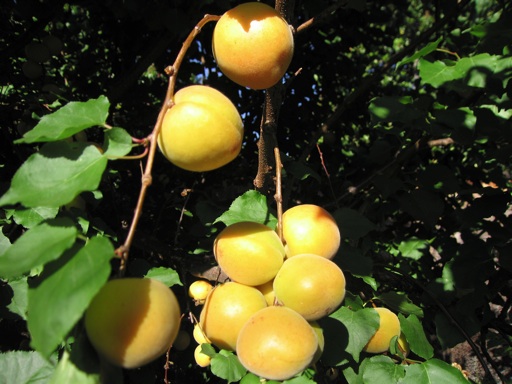
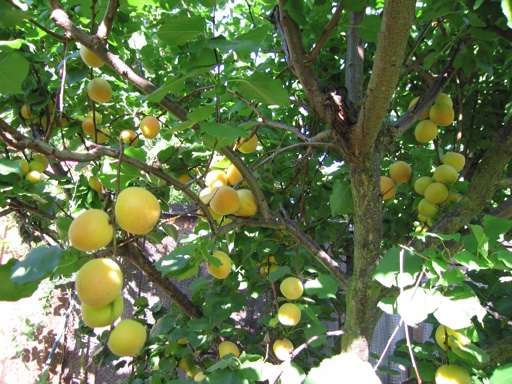
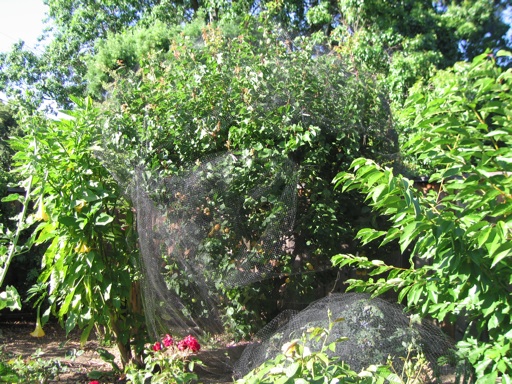
This season, our 10 year old Blenheim apricot tree has produced hundreds of apricots. It’s the same Blenheim apricot tree I blogged about in prior posts. The layers of netting wrapped around the sides, top and bottom of the tree kept out most of the critters. However, earwigs have gotten into several of them. Last weekend, I put a cardboard strip with tanglefoot around the trunk of the tree to deter the bugs from crawling up the tree at night. It seems to have helped.
I have already picked about half of the crop, and there is still over 100 unripe fruit left on the tree. Our home grown apricots are delicious as fresh fruit. But my favorite way to eat them is in an apricot crisp. Apricot crisp is a baked dessert of apricots and sugar covered with a butter crumble topping. It’s the best fruit pie in my opinion, the perfect balance of sweet and tart.
Last year, our apricot tree didn’t produce a single fruit, which I blame on the heavy rains that occurred during its bloom time. Heavy rains can damage apricot blossoms. Last March, forecasters predicted heavy rains again while our tree was in full bloom. So I covered the tree with a plastic sheet to protect the blossoms from damage. I have a picture of it covered in plastic in an earlier post on this blog. It seems to have worked.
After 10 years, this tree is in its prime. It grows very rapidly. It would grow about 4-6 feet or more per year in all directions if it weren’t for the fact that I prune it about 3 times a year. Typically, I prune once in January, once in early June just before netting it, and again in July or August after the fruit comes off. Keeping it a reasonable size makes the tree so much easier to net and to harvest the fruit. Between the pruning, netting, fertilizing, and picking, apricot trees (and fruit trees in general) can be a lot of work. But I enjoy the process, and I certainly enjoy the harvest.
July 07 2012 | Apricots | Comments Off on Apricots
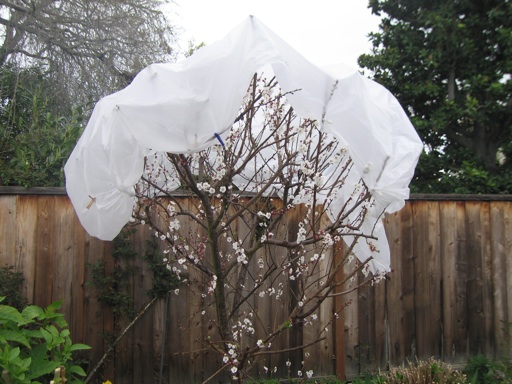
Last year, I did not harvest a single fruit from our Blenheim apricot tree. After a week or 2 of heavy rains in March 2011, the newly forming fruits were covered with mildew. Sometime later, they fell off.
This year, I am determined not to let rain ruin my apricot crop a second year in a row. So two weeks ago, when I heard that a week or more of rain was in our forecast, I decided to try an unconventional approach. I read on a website that some people cover their fruit trees to protect them from heavy rains. So I decided to give this technique a try.
Above is a picture of our apricot tree after we covered it with a clear plastic drop cloth. I used a .7 mil thick drop cloth that I purchased in the paint section of local big box home improvement store. I attached the drop cloth to the branches of the tree with clothes pins. I selected a thin drop cloth, because I wanted it to be easy to drape over the tree and light enough not to damage the blossoms. Getting the drop cloth on the tree was a challenge. We used a ladder and a pruning pole to drape the cloth over the tree and then spread it out. Our tree is only about 8-9 feet tall, because I prune it a lot. Trying to drape a drop cloth over a large tree would probably be impractical. The drop cloth stayed on the tree for a week through several days of rain including one night of heavy downpours. Last weekend, strong winds ripped it to shreds.
I left the apricot tree uncovered this past week, because we had dry weather. So far, it looks like the drop cloth was successful. Several small apricot fruits have already formed, and there is no sign of mildew on them.
However, a few days ago our weather forecasters predicted several more days of rain starting today. I think once most of the fruits have set they can survive the rain, but I don’t think they are there yet. Many of the apricot blossoms have just dropped their petals and have not formed fruit yet. That seems to be the time when they are most vulnerable to being knocked off by heavy rain or getting mildew after being exposed to several days of damp weather.
I covered our apricot tree again yesterday afternoon with a new clear drop cloth. This time I used a 1 mil 10′ x 20′ drop cloth, hoping the extra thickness would make it less prone to being torn by the wind. I also covered our multi-grafted pluot tree, which was easy to do because it’s so small (see picture below).

March 24 2012 | Apricots | Comments Off on Fruit Tree Umbrella
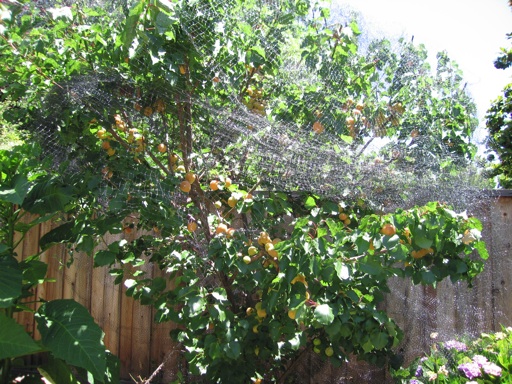
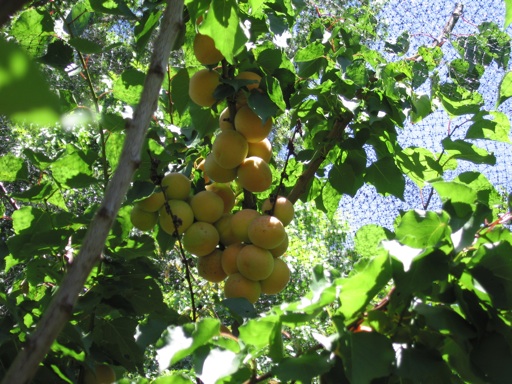
The 4th of July weekend is typically the time of year Blenheim apricots are at their peak of ripeness in our area. This year, my 8 year old Blenheim apricot tree had 200-300 apricots, which is an enormous amount of fruit compared to prior years. Last Monday, my mom and I spent the holiday picking the apricots and making apricot jam. Every year, I like to try making something new with apricots. This year, I decided to make apricot/orange conserve in addition to apricot jam. We made it by adding 2 cups of orange juice to an apricot jam recipe using oranges from my valencia orange bush. The apricot/orange conserve turned out to be especially good.
These pictures show my apricot tree a few days before we harvested the fruit. Fresh apricots are one of the things I look forward to with anticipation every summer. Like other types of stone fruits, they are in season for such a short time, but the flavor of home grown tree-ripened apricots makes them worth waiting for.
The bird netting I wrapped around the tree in mid-June kept the birds as well as the squirrels from harvesting the fruit before we did. Putting the netting on and taking the netting off is the most difficult part of growing and harvesting apricots in our yard. To make the process of netting the tree more manageable, I prune the tree heavily in the winter and once more in June just before putting the netting on to keep the tree about 10 feet tall. But besides the trouble of netting the tree, growing apricots is easy, at least in our climate. I fertilize the tree about once a year with all-purpose fertilizer and water it with an automatic drip system everyday in the summertime.
July 11 2010 | Apricots | Comments Off on Apricot Harvest
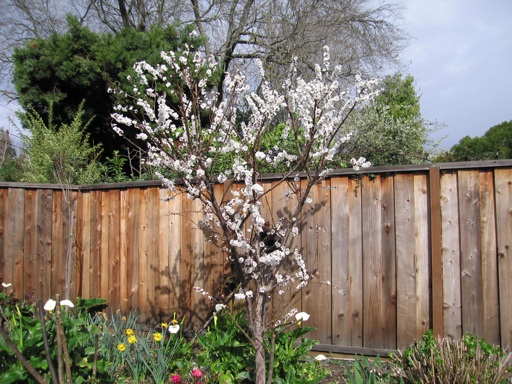
Our 8 year old Blenheim apricot tree just finished its bloom. I took this picture of it last weekend. It started blooming about 2 weeks ago. It was a beautiful but brief bloom. The rain we had here on Tuesday and Wednesday of this week knocked off most of the remaining petals. Our peach, nectarine, and Japanese plum trees are also in bloom now, and there appears to be no shortage of bees pollinating the blossoms.
These trees have always bloomed very early here. Although it varies from year to year, they typically bloom in late February and early March. I think that their tendency to bloom early is part of the reason many peach, nectarine, apricot, and Japanese plums are not recommended for cold climates that are prone to hard freezes late in the season in March and April. An early warm spell could trick them to into bloom and then a subsequent freeze might damage many of the flowers or newly forming fruit.
March 05 2010 | Apricots and Fruit | Comments Off on Apricot in Bloom
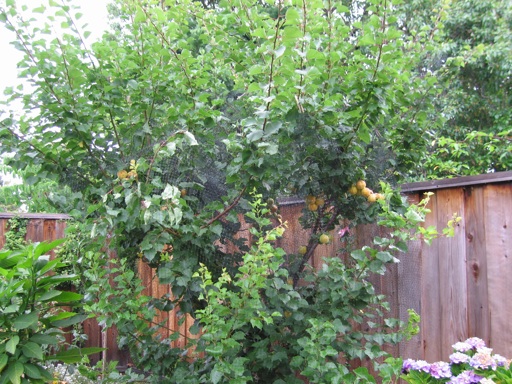
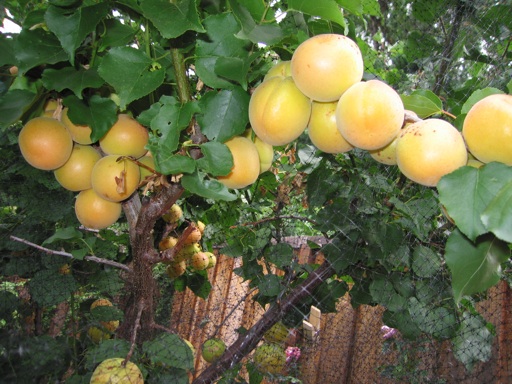
Yesterday, my mom came over to our house to help me harvest my first batch of Blenheim apricots of the year from the above pictured tree in our yard. We both love the taste of tree ripened Blenheim apricots. They seem to be the most flavorful apricot. My parents have a 30+ year old Blenheim apricot tree in their yard that is still producing quality fruit.
My tree is now 7 years old. Its fruit are large and have a very good flavor. They are much better tasting than the grocery store apricots I have eaten. Although, we both think that the fruit from my parents’ 30+ year old tree is much sweeter than the fruit from my young tree. Their apricots taste like a dessert. My guess is that a mature apricot tree has a greater ability than a young tree to generate sugars and produce sweeter fruits.
I have had to build a virtual fortress of bird netting around my apricot tree to keep the birds and squirrels from eating the fruit. So far, I have lost only a few fruits to the wildlife. I wrapped bird netting around all sides of the tree up to the upper weak branches and then tied it tightly around the bottom with string leaving no openings around the sides or the bottom for the squirrels to crawl through. I loosely draped the netting through the high branches to keep the birds from flying inside. This netting technique has mostly kept the bird and squirrels out.
A few days ago, I peeled away the netting to pick a few apricots and then didn’t reseal the netting tightly enough after I was finished. By the time I was back inside our kitchen, a squirrel had already found its way inside the netting. After shooing it away, I wrapped two extra nets around the tree for a total of 3 nets. There hasn’t been any more breaches since then. The two week period when apricots are ripening in late June and early July is the most important time to net. That’s when the birds and squirrels seem to to go after them the most.
July 02 2009 | Apricots | Comments Off on Harvesting Blenheim Apricots
Next »









